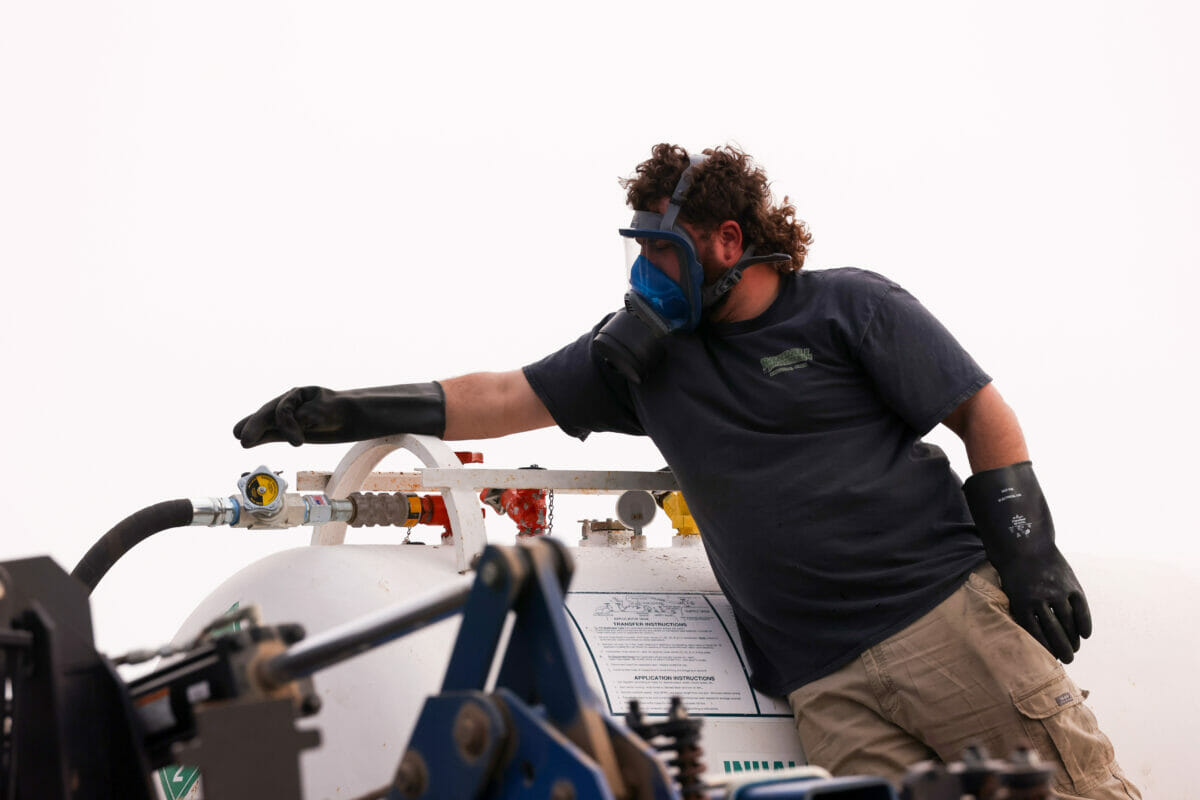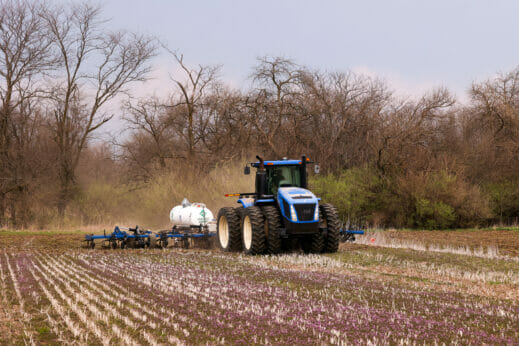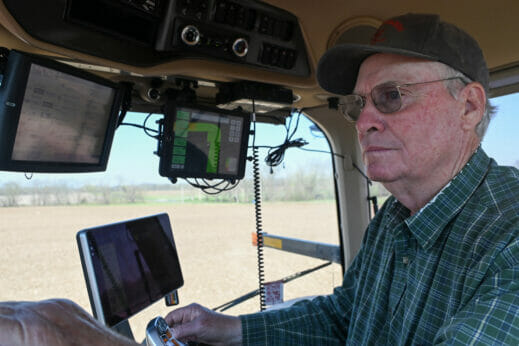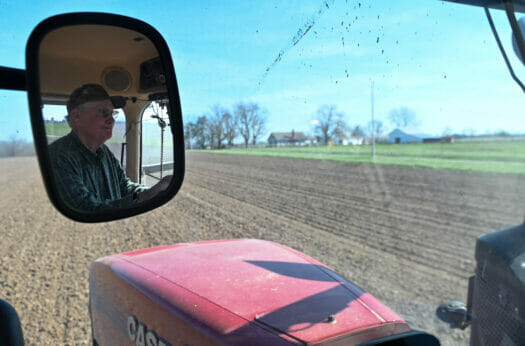Facing High Fertilizer Costs, Farmers Still Struggle to Use Less
Fertilizer use can harm the environment, but farmers rely on it for increased yield and profits.
Facing High Fertilizer Costs, Farmers Still Struggle to Use Less
Fertilizer use can harm the environment, but farmers rely on it for increased yield and profits.

Matthew Backer wears a gas mask as he spreads anhydrous ammonia onto a field on April 4 at Wise Bros Inc. in Kingdom City, Mo.Credit: by Kate Cassady/Columbia Missourian.
As a young boy in the late 1950s, Frank Glenn knew the soft, freshly-tilled brown dirt lining his family’s fields signaled the start of another planting season.
“Back when we were young buckaroos, we would plow and disc and get a crop of weeds to come up [and then] knock them down,” Glenn said.
Frank and his younger brother John would hop on the tractor and start pulling their blue plow through the fields in February and March. Then they would go back with a tiller and turn over the topsoil before planting corn, soybeans, wheat and oats.
Today, the Glenns are still running their family farm in Columbia, Missouri, growing corn, soybeans and hay. But about 25 years ago they transitioned to a majority no-till operation, no longer digging up the first few inches of soil before planting. Their fields are now filled with big clumps of dirt and old roots from previous harvests.

No-till farming helps decrease erosion and runoff. It’s one of several regenerative farming methods that help farmers’ fertilizer stay in fields and not run off into nearby waterways.
Rob Myers, director of the University of Missouri Center for Regenerative Agriculture, said less than half of Missouri farmers are using a regenerative method such as cover crops, no-till or integrating crops and livestock. Cost is one of the factors holding farmers back, Myers said.
Farmers use fertilizer to build their soil’s fertility and help increase crop yields. But less than half of the nitrogen fertilizer applied is taken up by the crops. These excess nutrients wash into the Gulf of Mexico, creating a dead zone where fish and shrimp cannot live. But nutrient pollution is not just an environmental problem—it’s a business one.
Farmers are responsible for the cost of implementing alternative practices, and they bear the risk if it doesn’t work. Bruce Shryock, a corn, soybean and wheat farmer in Auxvasse, said farmers are stuck between science and the economy.
“If you spend more and then don’t make any more, then you’re in trouble,” Shryock said.
Farmer finances on the line
A report from the University of Missouri found that net farm income in the state is projected to decrease by 14 percent this year, while the U.S. Department of Agriculture anticipates national farm income to fall by a fifth. Meanwhile, farmers’ input costs have increased 55 percent since 2020.
Fertilizer accounts for about a third of these annual costs, and it now costs farmers nearly 73 percent more than it did in 2020. But farmers continue to buy it because it offers a good return on investment, said Ray Massey, a professor in MU’s College of Agriculture, Food and Natural Resources.
“The economics said that you can make more money if you have higher yields,” Massey said.
Farmers also must factor in other input costs like seed, pesticide, equipment and fuel. Crop revenue has increased but the prices for inputs have continued to rise, so their margins have stayed about the same, Frank Glenn said.
“It seems like they (the ag industry) don’t want farmers to make any money,” he said.

Some farmers coped with the price increases by cutting back on the amount of fertilizer they apply. Glenn said he and his brother went from applying 180 pounds an acre to 120 pounds last year. He said they were lucky crop prices were high or they might have not been able to survive the fertilizer price hike.
“Jesus, it makes you wanna puke,” his brother John Glenn said. “It’s so expensive.“
Promoting intentional fertilizer use
Because fertilizer is expensive, farmers want to get the most bang for their buck, said Andrea Rice, director of research, education, and outreach at the Missouri Fertilizer Control Board.
The agency enforces Missouri fertilizer laws, conducts nutrient research and helps farms implement alternative farming methods.
Rice said high costs and current profit margins discourage farmers from applying more than the recommended amount, noting that farmers lose money if the fertilizer washes off their fields.
Heavy rain or snow melt washes fertilizer into waterways, polluting water and creating toxic algae blooms in lakes and rivers. Ultimately, some of this pollution travels downstream to the Gulf of Mexico and creates a hypoxic area called the dead zone at the mouth of the Mississippi River where water oxygen levels plummet. Any wildlife in these areas must move or suffocate.
“The Gulf hypoxia situation—that’s not something that any farmer would want to cause,” Rice said. But she said the problem did not appear overnight and is going to take time to solve.
Farmers have several ways of measuring how much fertilizer they need to apply to their fields. This includes soil testing and looking at past harvests to compare their yield to the amount of fertilizer they applied.
The Glenns use a satellite to create a grid of their fields and take samples from each block on the grid. They can see how their soil structure varies and pinpoint the exact nutrients each block needs.
Miscalculations such as applying too much fertilizer, applying it on frozen ground or overwatering fields will increase the runoff potential.
Sarah Carden, a senior policy advocate at Farm Action, an advocacy group opposing corporate influence in agriculture, said the industry is set up to support conventional farming, which disincentivizes alternative practices.
It’s easier for conventional farmers to qualify for crop insurance, Carden said, but it gets harder when a farmer wants to decrease the amount of fertilizer they use.
“It becomes a lot riskier for a farmer to participate in alternative forms of production,” Carden said.
Making change happen
One method farmers can adopt to minimize the harmful effects of fertilizer is to plant cover crops, which help decrease erosion, hold moisture in the ground and reduce weeds.
Integrating cover crops was a learning experience for Shryock, the farmer from Auxvasse. In his first year planting cover crops, a wet spring spurred his rye to grow to about eight feet tall. Getting that tall rye out of the field was a challenge, as it wrapped around his planter shaft and damaged the bearings on his equipment.
“I cussed it that first year,” he said.
Shryock has since learned to kill rye when it’s about two feet tall. He saw the benefits of cover crops after that first year as it helped his soil and decreased runoff.
Shryock also no-tills in addition to cover crops. These practices take more time, he said, but they’ve been worth it. He cut back on the amount of fuel he uses, but he still has to buy seed and pesticide and must spend time planting the cover crop. Shryock thinks more people would plant them if there was an incentive to help cover their costs.

Rice said education can help increase the adoption of cover crops, though some farmers are used to doing things the way they and their families always have.
She first advises new clients to do soil sampling. Then, she discusses the type of fertilizer they are using, the amount, application times and if they are using cover crops.
“If we take those things and we do a little bit at a time and we keep encouraging and keep educating over time, there will be a big impact,” Rice said.
The MU Center for Regenerative Agriculture has recently been awarded two grants: $25 million to offer financial incentives for farmers to implement regenerative practices and $10 million to research how to improve varieties of cover crops.
The grant will pay farmers to adopt grid sampling, cover crops and livestock grazing systems to decrease nitrogen runoff. It also will fund programs to help farmers learn about these methods and their benefits.
“It takes time to keep making changes and improvements in agriculture,” Myers said. “But I think we’re headed in the right direction with these practices.”
This story is part of The Price of Plenty, a special project investigating fertilizer from the University of Florida College of Journalism and Communications and the University of Missouri School of Journalism, supported by the Pulitzer Center’s nationwide Connected Coastlines reporting initiative and distributed by the Mississippi River Basin Ag & Water Desk.
Follow us
This work is licensed under a Creative Commons Attribution-NoDerivatives 4.0 International License.
Want to republish a Modern Farmer story?
We are happy for Modern Farmer stories to be shared, and encourage you to republish our articles for your audience. When doing so, we ask that you follow these guidelines:
Please credit us and our writers
For the author byline, please use “Author Name, Modern Farmer.” At the top of our stories, if on the web, please include this text and link: “This story was originally published by Modern Farmer.”
Please make sure to include a link back to either our home page or the article URL.
At the bottom of the story, please include the following text:
“Modern Farmer is a nonprofit initiative dedicated to raising awareness and catalyzing action at the intersection of food, agriculture, and society. Read more at <link>Modern Farmer</link>.”
Use our widget
We’d like to be able to track our stories, so we ask that if you republish our content, you do so using our widget (located on the left hand side of the article). The HTML code has a built-in tracker that tells us the data and domain where the story was published, as well as view counts.
Check the image requirements
It’s your responsibility to confirm you're licensed to republish images in our articles. Some images, such as those from commercial providers, don't allow their images to be republished without permission or payment. Copyright terms are generally listed in the image caption and attribution. You are welcome to omit our images or substitute with your own. Charts and interactive graphics follow the same rules.
Don’t change too much. Or, ask us first.
Articles must be republished in their entirety. It’s okay to change references to time (“today” to “yesterday”) or location (“Iowa City, IA” to “here”). But please keep everything else the same.
If you feel strongly that a more material edit needs to be made, get in touch with us at [email protected]. We’re happy to discuss it with the original author, but we must have prior approval for changes before publication.
Special cases
Extracts. You may run the first few lines or paragraphs of the article and then say: “Read the full article at Modern Farmer” with a link back to the original article.
Quotes. You may quote authors provided you include a link back to the article URL.
Translations. These require writer approval. To inquire about translation of a Modern Farmer article, contact us at [email protected]
Signed consent / copyright release forms. These are not required, provided you are following these guidelines.
Print. Articles can be republished in print under these same rules, with the exception that you do not need to include the links.
Tag us
When sharing the story on social media, please tag us using the following: - Twitter (@ModFarm) - Facebook (@ModernFarmerMedia) - Instagram (@modfarm)
Use our content respectfully
Modern Farmer is a nonprofit and as such we share our content for free and in good faith in order to reach new audiences. Respectfully,
No selling ads against our stories. It’s okay to put our stories on pages with ads.
Don’t republish our material wholesale, or automatically; you need to select stories to be republished individually.
You have no rights to sell, license, syndicate, or otherwise represent yourself as the authorized owner of our material to any third parties. This means that you cannot actively publish or submit our work for syndication to third party platforms or apps like Apple News or Google News. We understand that publishers cannot fully control when certain third parties automatically summarize or crawl content from publishers’ own sites.
Keep in touch
We want to hear from you if you love Modern Farmer content, have a collaboration idea, or anything else to share. As a nonprofit outlet, we work in service of our community and are always open to comments, feedback, and ideas. Contact us at [email protected].by Bailey Becker, Columbia Missourian, Modern Farmer
June 6, 2023
Modern Farmer Weekly
Solutions Hub
Innovations, ideas and inspiration. Actionable solutions for a resilient food system.
ExploreExplore other topics
Share With Us
We want to hear from Modern Farmer readers who have thoughtful commentary, actionable solutions, or helpful ideas to share.
SubmitNecessary cookies are absolutely essential for the website to function properly. This category only includes cookies that ensures basic functionalities and security features of the website. These cookies do not store any personal information.
Any cookies that may not be particularly necessary for the website to function and are used specifically to collect user personal data via analytics, ads, other embedded contents are termed as non-necessary cookies.
To what extent do farmers use manure? Could save on fertilizer.
Anhydrous ammonia kills every living organism it touches when it’s applied to soil. And it is widely used in tens of millions of acres in the Corn Belt and beyond. It “boosts yields” in the same way a heroin fix boosts a junkie.
I hear you, Shryock! Cover crops can be amazing, but getting the timing right takes some trial and error. I also no-till and find the long-term benefits outweigh the initial learning curve. Definitely agree on needing incentives to make it more accessible for more farmers.